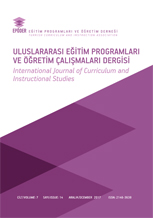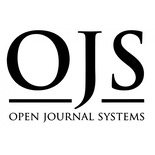A Need Analysis on Development of Creative Thinking Skills: A Phenomenological Study
Abstract
This study adopts a qualitative research design aiming at investigating the perceptions of English language teachers about creative thinking skills in their courses. Six teachers working at the School of Foreign Languages at a state university participated in this study. They had similar educational backgrounds and different years of experience. In terms of teaching English, participants were interviewed in-depth about the conceptualization of creative thinking skills. The purpose of the study was to identify teachers’ perspectives and their ways of implementing sub-dimensions of creative thinking in both face-to-face and online lessons. Semi-structured interview questions were used to collect data in the study and the data were analysed through content analysis method using NVivo 12. The findings of the research are grouped under the following headings: Barriers to Creating a Thinking Class Environment, Existing Supporters, and Defining the Concept. Results revealed that the teachers have defined the ability to think creatively considering the basic perception they had about the concept which is mainly creating new products. It is also understood that they evaluated the concept and associated the sub-dimensions accordingly. It can be inferred that a deeper understanding and well-organized teaching of creative thinking skills are required to be blended into the foreign language education.
Downloads
References
Ali, S. S. (2019). Problem based learning: a student-centered approach. English Language Teaching, 12(5). 73-78.
Al-Zahrani, A. M. (2015). From passive to active: The impact of the flipped classroom through social learning platforms on higher education students’ creative thinking. British Journal of Educational Technology, 46 (6) 1133–1148. doi:10.1111/bjet.12353
Asworth, P., & Lucas, U. (1998). What is ‘world’ of phenomenography? Scandinavian Journal of Educational Research, 42(4). 415-431.
Basal, A., Yilmaz, S., Tanriverdi, A., & Sari, L. E. (2016). Effectiveness of mobile applications in vocabulary teaching. Contemporary Education Technology, 7. 47–59.
Bedir, H. (2019). Pre-service ELT teachers’ beliefs and perceptions on the 21st century learning and innovation skills (4Cs). Journal of Language and Linguistic Studies, 15(1), 231-246. Doi:10.17263/jlls.547718
Borodina, T., Sibgatullina, A., & Gizatullina, A. (2019). Developing Creative Thinking in Future Teachers as a Topical Issue of Higher Education. Journal of Social Studies Education Research, 10(4). 226-245
Cesar, C. N. (2013). Creative thinking in digital game design and development: A case study. Computers & Education, 69. 320–331
Cornelius-White, J. (2007). Learner-centered teacher-student relationships are effective: A meta-analysis. Review of Educational Research, 77(1), 113–143.
Dolapçıoğlu, S., & Gürkan, B. (2020). Sosyal Bilgiler Dersinde Estetik Yaratıcılık Öğretim Etkinlikleriyle Yaratıcı Düşünme Becerilerinin Geliştirilmesi. Eğitim ve Bilim 45(202). 51-77
Eragamreddy, N. (2013). Teaching Creative Thinking Skills. IJ-ELTS: International Journal of English Language & Translation Studies, 1(2).
Gürsoy, E., & Bağ, H. K. (2018). Is it possible to enhance the creative thinking skills of EFL learners through training? Advances in Language and Literary Studies, 9(6). 172-182.
Haladyna, T. M. (1997). Writing test items to evaluate higher order thinking. Needham Heights, MA: Allyn & Bacon.
Jauk, E., Benedek, M., Dunst, B., & Neubauer, A. C. (2013). The relationship between intelligence and creativity: New support for the threshold hypothesis by means of empirical breakpoint detection. Intelligence, 41. 212–221
Karpova, E., Marcketti, S. B., & Barker, J. (2011). The efficacy of teaching creativity: Assessment of student creative thinking before and after exercises. Clothing & Textiles Research Journal, 29(1), 52–66. https://doi.org/10.1177/0887302X11400065
Kaya, E., Ayaz A. D., & Dündar, T. (2017). Challenges in EFL Speaking Classes in Turkish Context. European Journal of Language and Literature Studies, 3(2). 66-74.
Klimova, B. (2019). Impact of Mobile learning on students’ achievement results. Education Science, 9 (90).
Kuo, F., Chen, N., & Hwang, G. (2014). A creative thinking approach to enhancing the web-based problem solving performance of university students. Computers & Education, 72. 220-230.
Lin, C. (2016). Effects of Web-Based Creative Thinking Teaching on Students’ Creativity and Learning Outcome. Eurasia Journal of Mathematics, Science & Technology Education, 12(6), 1675-1684 doi: 10.12973/eurasia.2016.1558a
Mehrabian, N., & Salehi, H. (2019). The effects of using diverse vocabulary learning strategies on word mastery: a review paper. Journal of Applied Studies in Language, 3(1). 100—114.
Mohammed, A., Ali, R., & Aldalan B. (2020). Using U-Learning in developing creative thinking levels among university students. International Journal of Scientific & Technology Research, 9.
Moustakas, C. (1994). Phenomenological Research Methods. United States of America: SAGE Publications.
Nematollahi, B., Behjat, F., & Kargar, A. A. (2017). A Meta-Analysis of Vocabulary Learning Strategies of EFL Learners. English Language Teaching, 10(5).
Putri, Z. M., & Wahyuni, E. (2019). Vocabulary Learning Strategy Employed by High-Achiever University Students at Malang. CELTIC: A Journal of Culture, English Language Teaching, Literature & Linguistics, 6(1).
Read, C. (2015). Seven pillars of creativity in primary ELT. In Maley, A., & Peachey, N. (Eds.), Creativity in the English language classroom, 29-36. London: British Council.
Sadykova A. G., & Shelestova, O. V. (2016). Creativity Development: The Role of Foreign Language Learning. International Journal of Environmental & Science Education, 11(15). 8163-8181.
Singh, S., C. K., Singh, T. S. M., Ja’afar, H., Tek, O. E., Kaur, H., Mostafa, N. A., & Yunus, M. M. (2020). Teaching Strategies to Develop Higher Order Thinking Skills in English Literature. International Journal of Innovation, Creativity and Change, 11(8).
Solak, E. (2015). Current challenges in English language learning in Turkish EFL context. Participatory Educational Research, 2(1), 106-115. http://dx.doi.org/10.17275/per.15.09.2.1
Şahin, H., & Han, T. (2020). EFL Teachers’ Attitude Towards 21st Century Skills. The Reading Matrix: An International Online Journal, 20(2).
Tabieh, A. A. S., Hileh, M. M., & Al-Shakea, H. M. F. (2020). Blended and Flipped Learning: entreprenuerial teaching strategies for acquiring creative thinking skills. Humanities & Social Sciences Reviews, 8(4). 745-754. https://doi.org/10.18510/hssr.2020.8474
Tomlinson, B. (2015). Challenging teachers to use their coursebook creatively. In Maley, A., & Peachey, N. (Eds.), Creativity in the English language classroom, 24-28. London: British Council.
Torrance, E. P. (1965). Scientific views of creativity and factors affecting its growth. Daedalus 94(3), 663-681.
Torrance, E. P. (1972). Can we teach children to think creatively? Retrieved October 12, 2020, from https://files.eric.ed.gov/fulltext/ED061544.pdf
Tsai, K. C. (2013). Being a critical and creative thinker: A balanced thinking mode. Asian Journal of Humanities and Social Sciences, 1(2).
Wang, Y. (2015). Promoting collaborative writing through wikis: a new approach for advancing innovative and active learning in an ESP context, Computer Assisted Language Learning, 28(6), 499-512. DOI: 10.1080/09588221.2014.881386
Yang, Y. C., Chen, Y., & Hung, H. (2020). Digital storytelling as an interdisciplinary project to improve students’ English speaking and creative thinking. Computer Assisted Language Learning, DOI: 10.1080/09588221.2020.1750431
Yustina, R., Syafii, W., & Vebrianto, R. (2020). The effects of blended learning and project-based learning on pre-service biology teachers’ creative thinking through online learning in the Covid-19 pandemic. Jurnal Pendidikan IPA Indonesia, 9(3). 408-420
Zohar, A. & Dori, Y. J. (2003). Higher Order Thinking Skills and Low- Achieving Students: Are They Mutually Exclusive? The Journal of the Learning Sciences, 12(2). 145-181, DOI: 10.1207/S15327809JLS1202_1




